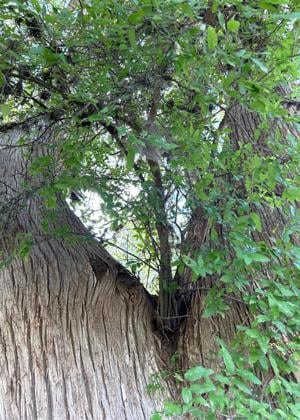
Dear Neil: We have property with a very large cypress tree. Growing out of a fork in the tree, about 5 feet up, there is a hackberry tree. Will it eventually harm the cypress? What is the best way to remove it? A: Let’s put it this way: it won’t do anything positive to help the cypress.
It must be forming some kind of wedge within the wood of the cypress. If it were mine, I would cut it as flush as I could with the place where it emerges from the cypress. I would carefully drill into the stump of the hackberry and use an eyedropper to put a broadleafed weedkiller into the hole at full strength.

Just be careful that you do not drill through the hackberry and into the wood of the cypress. You won’t need a very large hole — just the size of a pencil and a half-inch deep. I do worry about how much debris there must be in the crotch of the cypress that it can hold moisture and nutrients enough to support the hackberry over a long, dry summer.
You might want to have a certified arborist look at this before you do anything. Dear Neil: Why are squirrels half-eating so many of the green pecans from our very large tree? They make a big mess when they drop the remains all over our deck. A: I can add to that: they make a big mess on our concrete paver driveway as well.
We live in a pecan forest, and this premature “harvest” begins by late August. The squirrels have run out of food in nature and the pecans tempt them so much that they simply can’t wait. I’ve been dealing with them for more than 40 years and I’ve learned long ago that there isn’t much I can do except to blow the fallen pecans off to the sides so they don’t get crushed into the porous pavers.
Dear Neil: We have a 6-year-old Monterey oak. Until the past month or so it has been growing normally. Now, however, it’s leaning.
It looks like it’s being pushed at the base by one of its roots. Is this cause for concern? Is there any way to brace it? A: The root is the total cause for concern. Look closely and you’ll see how the trunk is growing over it.
The root is girdling the tree. It is starting to cut off the supply of water and nutrients up to that side of the canopy of the tree. In the process, it is forcing the tree to lean.
I guess a dentist could compare it to what one errant tooth could do to an adjacent tooth, just a little at a time over a long period of months. That root needs to be removed. It should have been done several years ago.
Fall is the best time to do so since the weather will soon start to cool. It’s going to be a challenging process, and I’m also going to refer you to a certified arborist. Those are men and women who have been through a testing program of the International Society of Arboriculture.
If for any reason you are unable to find one, I would use a chisel to remove the root carefully from the side closest to the light. You can easily enough use an axe or pruning saw on the opposite side. Hopefully the tree will right itself after the root is gone.
You won’t be able to pull it back into vertical with cables or wires. If it has gotten to the point that the lean is permanent, you’ll either have to live with it or dig and replant it (not advised). Good luck! Dear Neil: I am attaching photos of some Leyland cypress trees we have had for two years.
Last year there was dying of some limbs. A nurseryman told us it was due to the high temperatures, so we replaced two of them. This year the same thing has happened.
Do you have any suggestions? A: My answer will break your heart. Leyland cypress trees all across Texas, the South and East have been dying due to a disease known as Seiridium canker for the past 25 years. It usually attacks trees that are a bit older than yours, but that’s not important to my answer — the symptoms are the same.
When you examine infected trees, you often will see black ooze seeping down their trunks. One would think that a fungal infection would have an easy control, but there is none for this disease. It has killed, I would guess, as many as 60 to 75 percent of the Leyland cypresses in Texas landscapes.
Italian cypresses started showing the same issues about 15 years ago, and more recently I have even seen Arizona cypresses dying from a variation of it. You would be better served with a planting of the Texas native eastern redcedar (Juniperus virginiana). It has become a common plant in commercial landscapes because of its durability to our climate and resistance to problems.
Have a question you’d like Neil to consider? Email him at [email protected] . Neil regrets that he cannot reply to questions individually.
For the holidays: Get inspiring home and gift ideas – sign up now!.














